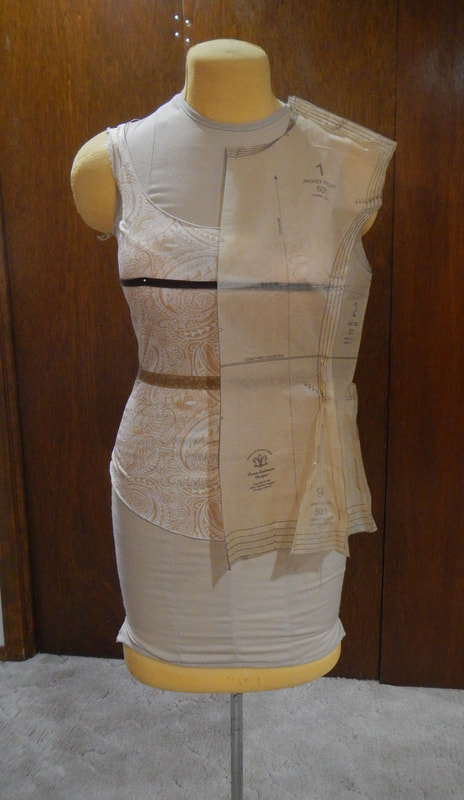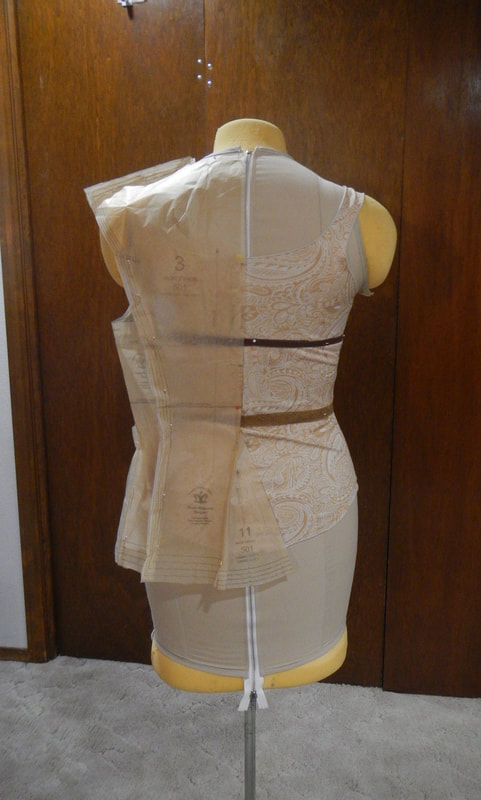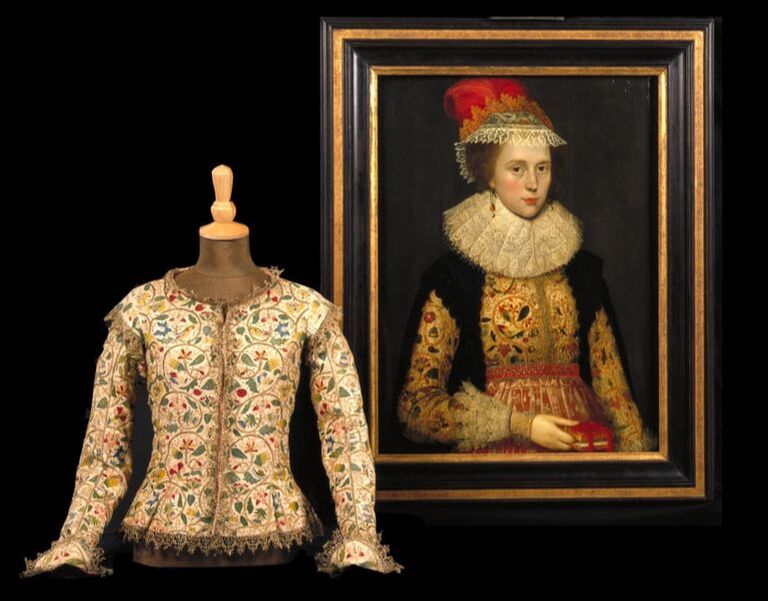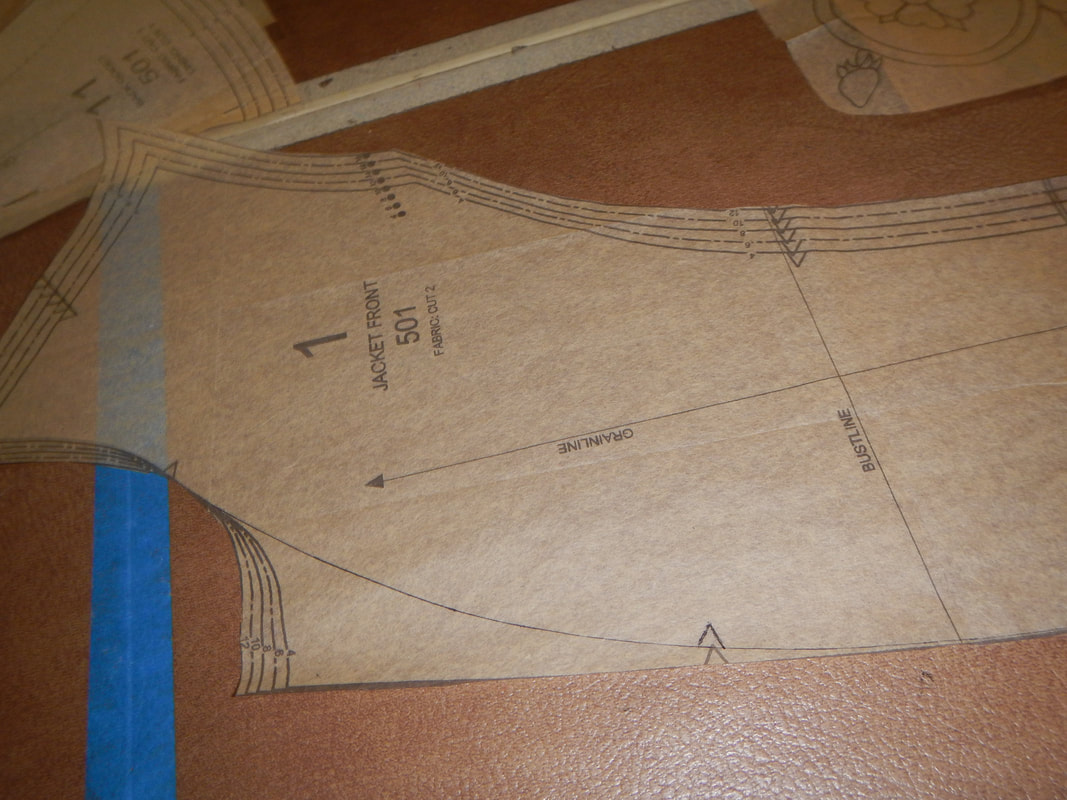PATTERN
I decide to get the Dawn Anderson one, and my friend buys it for me as thanks for cat-sitting. THE FABRIC Since I'm quarantine-sewing, I will work with what I have. And what I have for this project is a nice piece of laundered linen with machine embroidery on it that makes me think of blackwork embroidery. But, since I only have a yard of it, I pick another fabric of similar weight: a cotton twill in buttercup yellow. If I trim it with black, or embroider it, it'll look well with the linen. The pattern calls for a lining, too, but I haven't decided yet if I'll line it. I have to see what I have in my stash! TISSUE FITTING I often skip this step, but because my historical garments always involve lots of handwork, I am motivated to get the fit right before pouring time into the sewing and embellishment. Here's the tissue pattern, cut out to size 12, hanging on Mimi. Mimi is wearing my bra and generally matches my size and shape. My sole concern is the side panel, which seems too loose. See how much I can pinch into a dart? I don't want to narrow that panel, though, because doing so would change the shape of the armscye, which would mean altering the sleeves, which is a huge hassle. Instead, I could simply pull it tight by shaving some inches off the back panel... there's no side seam to get skewed, after all. But before I make any changes to the pattern, I try the tissue paper on myself, on top of the winter shirt I'm wearing, and it seems perfect. No weird bagginess when I wear it over clothes. So, since it's a jacket, I'm going to leave the side as is. Tissue-fitting done: no changes! RESEARCHING NECKLINES This patterns neckline bothers me... it feels like the standing collar is just tacked on. So I go looking, and learn a bit along the way. First, (as mentioned above) I learn that the jackets of this type are early-Jacobean in date. The natural waistline is a big shift from the low and pointy waistlines that had dominated women's clothing since the Tudor era and throughout Elizabeth's reign. Second, I find that when looking at this style of jacket, three types of necklines are seen: the jewel, the v-neck, and the jewel with sewn-on collar. Jewel neckline Here's a marvelous example from the Jacobean era: The jewel neckline is right, but there's no standing collar, because it was worn with a separate lace collar. The Elizabethan Costume site has good close-up pics of the embroidery. Another jewel neckline. And another... this one with unusual embroidery. I like the split sleeves on this one. The "Maidstone Jacket", held in the Maidstone Museum & Art Gallery, is another collarless example. This jacket is an excellent example of several unusual aspects of Elizabethan costuming: you can see that the bodice is actually, literally, a "pair of bodies". The right side and the left side were made and finished separately. To wear it, you'd have to hook it closed in front and lace it closed in back. The sleeves, likewise, were separate pieces, held on with laces or ties. It seems like so much work, to me, to get dressed in so many pieces, but thus did the modern jacket begin! V-necks Portrait of Susan, Lady Grey This Waistcoat from 1610--1620 Unknown lady Lady Elizabeth Powis Sewn-on collar This 1600's bodice has a collar very similar to Dawn Anderson's design! The Art Institute of Chicago is displaying it with the collar down. This jacket, alas, only has a back view, but it does show the back of the collar is a different color than the jacket, so a sewn-on collar seems plausible. This stray image, floating about the internet with no source page or attribution. So Dawn Anderson's pattern isn't wrong: the sewn-on collar above jewel neckline did exist; there are surviving examples of it. It is curious that I don't see it in portraits, though... maybe the standing collar served to support the larger, lace ruff? It could be structural rather than decorative. Regardless, I'm not happy with the look for my project. I decide to keep the sewn-on collar, because it gives such a historic look, but cut the jewel neckline to be more of a V. NEW NECKLINE FOR ME
I think the new neckline is much more graceful than the original. That's enough for now! I have to pre-wash my yellow cotton twill before I can continue this project! While I work on that, you can check out the work of Mary Addison, an embroiderer who did a marvelous Modern Elizabethan jacket! She went for a modern cut with historic embroidery, while I'm going for a historic cut with modern machine embroidery.
2 Comments
The Sister
3/30/2020 08:59:12 am
Ah, I do love the look of split sleeves. They make me think of the doublets pictured in the Great Illustrated Classics version of "The Prince and the Pauper", and didn't we all have a crush on Sir Miles? *swoon* And Mary Addison's embroidery work is quite impressive! I can't wait to see what you come up with!
Reply
My work will be rougher, for two reasons: first, because when I KonMari'd my room, I got rid of my crewel embroidery thread, so now I'm working with my friend's leftover knitting yarn; second, because I am impatient!
Reply
Leave a Reply. |
Karen Roy
Quilting, dressmaking, and history plied with the needle... Sites I EnjoyThe Quilt Index Categories
All
Archives
March 2024
|













 RSS Feed
RSS Feed